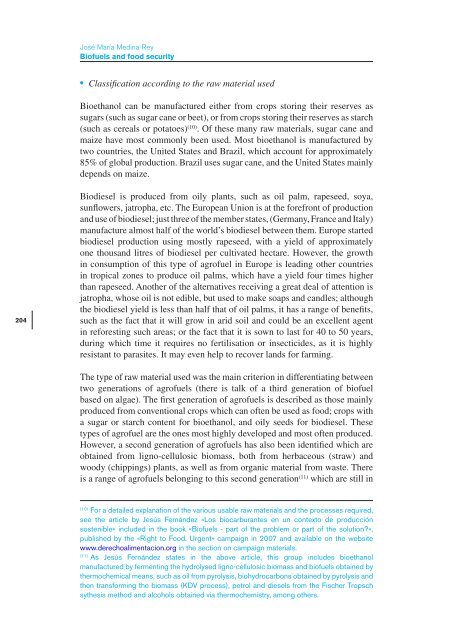Food security and global security - IEEE
Food security and global security - IEEE
Food security and global security - IEEE
- No tags were found...
You also want an ePaper? Increase the reach of your titles
YUMPU automatically turns print PDFs into web optimized ePapers that Google loves.
José María Medina ReyBiofuels <strong>and</strong> food <strong>security</strong>• Classification according to the raw material usedBioethanol can be manufactured either from crops storing their reserves assugars (such as sugar cane or beet), or from crops storing their reserves as starch(such as cereals or potatoes) (10) . Of these many raw materials, sugar cane <strong>and</strong>maize have most commonly been used. Most bioethanol is manufactured bytwo countries, the United States <strong>and</strong> Brazil, which account for approximately85% of <strong>global</strong> production. Brazil uses sugar cane, <strong>and</strong> the United States mainlydepends on maize.204Biodiesel is produced from oily plants, such as oil palm, rapeseed, soya,sunflowers, jatropha, etc. The European Union is at the forefront of production<strong>and</strong> use of biodiesel; just three of the member states, (Germany, France <strong>and</strong> Italy)manufacture almost half of the world’s biodiesel between them. Europe startedbiodiesel production using mostly rapeseed, with a yield of approximatelyone thous<strong>and</strong> litres of biodiesel per cultivated hectare. However, the growthin consumption of this type of agrofuel in Europe is leading other countriesin tropical zones to produce oil palms, which have a yield four times higherthan rapeseed. Another of the alternatives receiving a great deal of attention isjatropha, whose oil is not edible, but used to make soaps <strong>and</strong> c<strong>and</strong>les; althoughthe biodiesel yield is less than half that of oil palms, it has a range of benefits,such as the fact that it will grow in arid soil <strong>and</strong> could be an excellent agentin reforesting such areas; or the fact that it is sown to last for 40 to 50 years,during which time it requires no fertilisation or insecticides, as it is highlyresistant to parasites. It may even help to recover l<strong>and</strong>s for farming.The type of raw material used was the main criterion in differentiating betweentwo generations of agrofuels (there is talk of a third generation of biofuelbased on algae). The first generation of agrofuels is described as those mainlyproduced from conventional crops which can often be used as food; crops witha sugar or starch content for bioethanol, <strong>and</strong> oily seeds for biodiesel. Thesetypes of agrofuel are the ones most highly developed <strong>and</strong> most often produced.However, a second generation of agrofuels has also been identified which areobtained from ligno-cellulosic biomass, both from herbaceous (straw) <strong>and</strong>woody (chippings) plants, as well as from organic material from waste. Thereis a range of agrofuels belonging to this second generation (11) which are still in(10)For a detailed explanation of the various usable raw materials <strong>and</strong> the processes required,see the article by Jesús Fernández «Los biocarburantes en un contexto de producciónsostenible» included in the book «Biofuels - part of the problem or part of the solution?»,published by the «Right to <strong>Food</strong>. Urgent» campaign in 2007 <strong>and</strong> available on the websitewww.derechoalimentacion.org in the section on campaign materials.(11)As Jesús Fernández states in the above article, this group includes bioethanolmanufactured by fermenting the hydrolysed ligno-cellulosic biomass <strong>and</strong> biofuels obtained bythermochemical means, such as oil from pyrolysis, biohydrocarbons obtained by pyrolysis <strong>and</strong>then transforming the biomass (KDV process), petrol <strong>and</strong> diesels from the Fischer Tropschsythesis method <strong>and</strong> alcohols obtained via thermochemistry, among others.
















